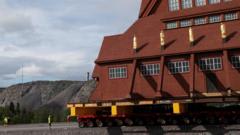Engineering Feats: The Monumental Move of a Swedish Church
 The Tech Times
The Tech Times
In a stunning demonstration of engineering prowess and logistical coordination, a Swedish church was moved to a new location using giant trailers—a feat that captures the imagination and showcases human ingenuity. This audacious relocation project not only highlights the capabilities of modern technology but also reflects a deep respect for cultural heritage. While the specifics of why the church needed to be moved are intriguing, the event itself is a testament to the challenges and triumphs of preserving history in the face of contemporary challenges.
Historical Context and Significance
The relocation of buildings is not a new concept. Historically, structures have been moved for a variety of reasons—urban development, preservation, and even environmental concerns. One of the most famous examples is the relocation of the temples of Abu Simbel in Egypt. In the 1960s, the construction of the Aswan High Dam threatened to submerge these ancient monuments. An international effort, coordinated by UNESCO, saw the massive stone temples painstakingly cut into blocks and reassembled on higher ground. This project set a precedent in architectural conservation, illustrating the lengths to which humanity will go to preserve its heritage.
In Sweden's case, the church's move underscores a similar commitment to heritage conservation. It also raises fascinating questions about the balance between historical preservation and modern necessity. As cities expand and landscapes change, the challenge lies in maintaining the integrity of historical sites while accommodating progress.
The Engineering Marvel
The logistical challenges of moving a church are immense. It requires meticulous planning and precision engineering. The structure must be stabilized to prevent damage, and the route must be carefully mapped to avoid obstacles and ensure safety. The use of giant trailers for such a task exemplifies the intersection of traditional craftsmanship and modern technology—a synergy that enables seemingly impossible feats.
The process begins with extensive surveys and structural assessments. Engineers must determine the building's weight and center of gravity, design specialized supports, and plan the route meticulously. The transportation itself often involves coordinating with local authorities to navigate around existing infrastructure and minimize disruption. The successful execution of such a project is a testament to human ingenuity and the power of collaboration.
Cultural and Modern Implications
The decision to relocate a church rather than demolish it speaks volumes about the value placed on cultural heritage. It reflects a societal shift towards sustainability and preservation. In an era where rapid urbanization often leads to the demolition of historical sites, Sweden's choice serves as a reminder of the importance of maintaining a tangible connection to the past.
Moreover, this event highlights the potential for technology to aid in preservation efforts. As our world becomes increasingly digital, the use of advanced engineering techniques in conservation projects can inspire similar endeavors globally. It provides a blueprint for how societies can embrace progress without sacrificing history.
Conclusion
The relocation of the Swedish church on giant trailers is more than a remarkable engineering achievement; it is a symbol of respect for the past and a commitment to preserving it for future generations. As we move forward in an ever-evolving world, it is crucial to remember that progress and preservation are not mutually exclusive. Instead, they can coexist, creating a richer, more culturally vibrant world.
Such projects encourage us to think creatively about how we approach the challenges of modern development while honoring the legacies of our ancestors. As technology continues to advance, the possibilities for preservation are limitless, offering hope that we can continue to celebrate our history while building a better future.
Source: Weekly quiz: Why was a Swedish church moved on giant trailers?
Subscribe to my newsletter
Read articles from The Tech Times directly inside your inbox. Subscribe to the newsletter, and don't miss out.
Written by
